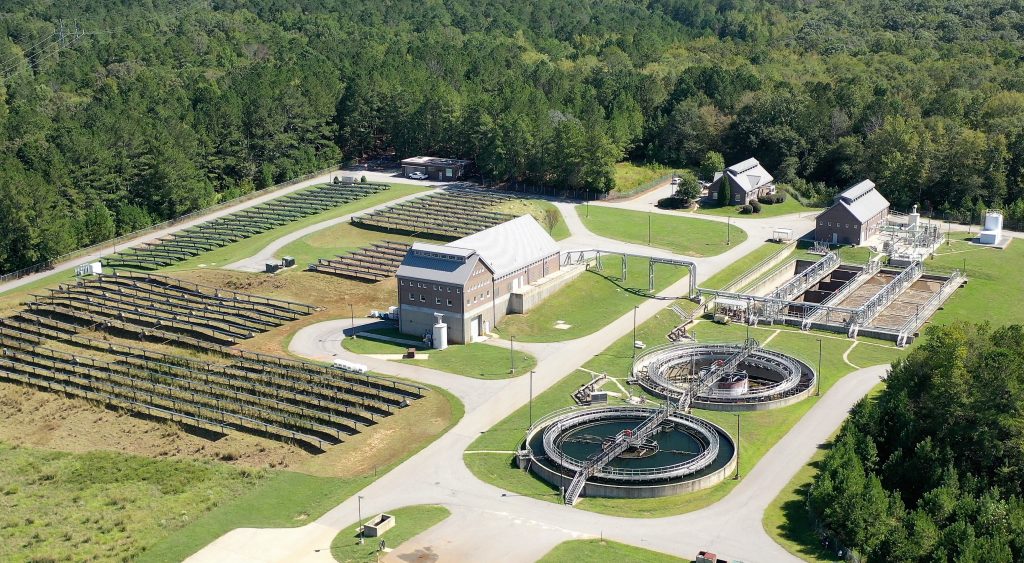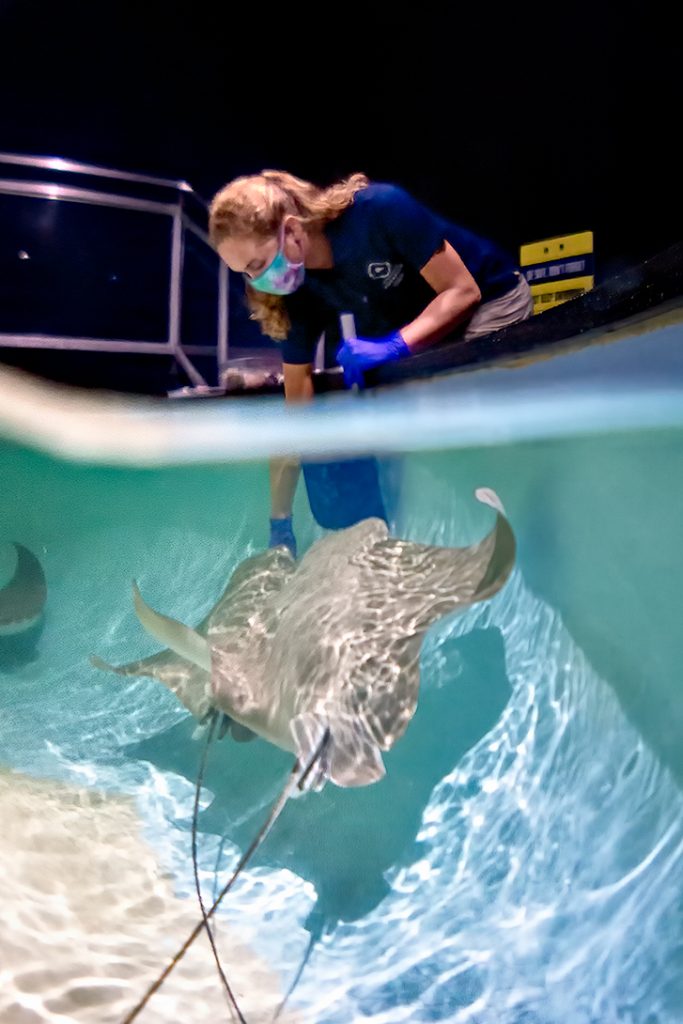
It’s time to vote in the #ELGLKnope Sweet Sixteen! Read about this matchup, and then submit your vote! One vote per email address, please. We’ll tally the votes and will post the next round of matchups on Tuesday!
Vote! Vote! Vote!

Cedar Creek Water Reclamation Facility
Athens, Georgia 30605
- Three words to describe Cedar Creek Water Reclamation Facility: Indispensable, Poopular, Sparkling
- Why are you nominating Cedar Creek Water Reclamation Facility: I write to nominate the Cedar Creek Water Reclamation Facility in Athens, GA. I hope my story below explains why I believe this location is worthy of competing for the #ELGLKnope Award.The threatening weather could have played perfectly into the scheduled Halloween-themed Trick or Treatment event. However, we decided the drizzling, wet, and foggy conditions were not ideal for a Cedar Creek Water Reclamation Facility (WRF) tour. We sent word of the last-minute cancellation along with our regrets to the registered tour participants.
As I approached the facility gate to head home, I saw a waiting car. Perhaps someone who hadn’t received the news of the cancellation? I rolled down my window to find a young knight, Spiderman, and their parents in the other vehicle. They had not gotten the message about our need to postpone.
Per the Halloween tour instructions, the boys had dressed in costume, ready for their visit. The parents’ eyes pleaded with me as they explained how their oldest son was always asking what happens to the water after he flushes the toilet. They had promised to show him the path of his poop. As if on cue, the rain stopped. Not wanting to be one who disappoints, I offered to go ahead with the tour so these curious boys could solve the mystery of the flush.
I introduced the family to Cedar Creek WRF, the smallest of three such facilities in Athens, GA. Cedar Creek WRF rests on 40 acres nestled within a larger 500-acre wooded area. We recently installed a solar array on an open grassy field to offset energy costs and meet the local government’s ambitious green energy goals. I shared with my guests that we often hire sheep – yes, the wooly kind – to come in and mow beneath the solar panels. Lawnmowers can throw rocks and break the panel glass; goats chew the necessary wires and tend to jump on top of the array. Sheep are who “ewe” want for the job.
We followed along the treatment train that almost 2 million gallons of collected water flow every day. At the band screens, a ghost floated nearby. This particular apparition was a “ghost” made of past flushable wipes, a tour decoration still waiting to haunt. The knight and Spiderman stopped for a photo while learning about the importance of the 4 Ps of Flushing: Only Pee, Poo, Paper, & Puke go down the toilet.
I explained to my guests that Cedar Creek WRF relies on a return-activated sludge treatment process. Our operators create the perfect environment for billions of microorganisms to flourish. These little buggers remove the contaminants from the water. With so many decomposers on-site, including the fantastic water bears, Cedar Creek WRF is a favorite annual school visit for hundreds of fourth and fifth graders learning about beneficial microorganisms firsthand. Since the pandemic has suspended tours, we created a video tour to virtually introduce classrooms and others to the concept of water reclamation. Rather than cancel our very poopular annual Valentines’ Day Romantic Tour of the WRF due to COVID restrictions, we were able to adapt and use the video for an online event this year.
The sludge/biosolids removed from the process first go to the dewatering building, then travel to a compost production area and get mixed with leaves and limbs to create compost. Residents can purchase the compost for use in their flower gardens. The tour guests were surprised to see that the biosolids resemble plain ol’ dirt.
We climbed the ladder to the top of the clarifying basin where the sludge settles, then carefully crossed over the million gallons of water held in the 18 ft. deep tanks without the need for Spiderman’s web-slinging abilities. Next, we walked to the ultraviolet lights, the final step in the treatment process. After UV disinfection, the water cascades over a series of stairs to add oxygen back to the water before returning to the source to flow to the next community who will pull it for drinking water. And with that, the knight’s burning question as to what happens after he flushed was answered.
Cedar Creek WRF isn’t unique in the way it treats the water it collects. You find this same treatment process in hundreds of other facilities across the nation. What makes this location different is how it engages with the community. This quaint facility’s small size makes it an ideal place for a quick tour, with over 3,000 people taking advantage of this opportunity. Solar panels, sheep, a tour video, coloring books, on-location social media posts, public tours, and the occasional tootsie roll parting gift following a tour are a few ways Cedar Creek engages and differentiates itself from the competition.
At Cedar Creek, we avoid using the term “wastewater” with the public, for it doesn’t accurately describe the work done here. Yes, we remove waste from the water collected, but we do not waste a drop of water. Our facility recognizes water is too important to waste, so we hesitate to combine the two words. And despite our facility’s public perception, including that of our Halloween tour guests, the solid waste, aka poop, makes up a fraction of what is in the water received. We stress this concept to the public, choosing to focus on our finished product, clean water.
What truly makes Cedar Creek WRF extraordinary is the staff. Working from home was not an option in response to the pandemic. Someone was/is on hand 24/7, making the WRF operators work the definition of an essential service. They protect our water, public health, environment, community, and those living downstream. Stopping is not an option. I hope you accept my nomination for Cedar Creek WRF into the March bracket competition. We look forward to having another outlet to showcase our work and share the story of how water impacts every corner of Athens, GA.
- Anything else to share? I think of this facility as one of the Seven Wonders of Athens, GA. Thank you for considering this gem for the brackets.

Virginia Aquarium & Marine Science Center
717 General Booth Blvd, Virginia 23451
- Three words to describe Virginia Aquarium & Marine Science Center: Water’s Our World
- Why are you nominating Virginia Aquarium & Marine Science Center: Water is our world and there is no better destination to enjoy it, no better place to learn about it, no better mission to join than the Virginia Aquarium & Marine Science Center. Home to more than 5,000 animals representing more than 230 different marine species, we are intimately invested in the present health and future sustainability of water. We are aqua avengers, water warriors, and hydro heroes! From the 12-14 million gallons of water processed daily through our state-of-the-art recirculating filtration plants, to the tiniest drops of water being examined under the microscopes in our water quality lab, we keep a keen eye on the quality of water, not only for maintaining impeccable care for the animals, but also the health of the entire Chesapeake Bay region and beyond.We are intimately aware of the ramifications of not conserving this resource. Water is vital to the survival of all marine species and the entire planet. The finned, footed, and feathered Aquarium residents act as ambassadors for the millions of other lives on Planet Earth. Naturally, these animals have a vested interest in the conservation of water. But, so do we all.
The focus and mission of the Virginia Aquarium & Marine Science Center is to “inspire conservation of the marine environment,” making the conservation of healthy water clearly a top priority. We literally exist to inspire conservation of the precious limited water resources we all share – for a livable now and a sustainable future. Our nationally acclaimed Stranding Response Program works tirelessly to save endangered marine species, shining a light on the sad realities of not placing a high enough value on water. Our Education Team creates hundreds of resources of all kinds for educators, including classroom teachers, homeschooling parents, scout leaders, and more where water conservation is literally the learning objective. We know that to successfully stay on the mission of water conservation, we must reach the next generation of water stewards, conservationists, and superheroes. Whether it’s appealing to our government legislators to ban intentional balloon releases on behalf of at-risk sea turtles or chatting with a guest about how she can take small personal steps like not using straws, our message is laser focused on water.
The Virginia Aquarium & Marine Science Center facilities are located in three primary buildings along Owls Creek in Virginia Beach, VA. This “salt creek” serves as a primary source for brackish and seawater supplies, but we also use domestic tap water for our human needs and when further processed, for onsite use in the aquariums. We dechlorinate domestic water and process it for general aquarium use, deionize water for specialized needs, and when necessary, augment the creek water. No less than 6 types of water are used onsite daily – a double watery hat trick for sure!
We rely on a diverse group of experts and dedicated workers in the field to make this complex operate efficiently and effectively in delivering on our mission. We have sections dedicated to water quality (equal part alchemists and instrumentation pros), life support (focused on system design, maintenance, and operations), and of course our live exhibits (an equivalent mix of life support and department of health for the critters) that strive daily to provide excellence in service to our community and regional visitors. Our combined efforts affect real economic impact for the Chesapeake Bay region and we serve as global leaders in the conservation and sustainability of our aquatic resources.
So yes, we are an amazing, fun, and educational destination for guests of all ages. We provide opportunities for people to come face to face with amazing animals. We are engaged in species protection programs and important conservation research with similar groups around the world. But, as our work clearly demonstrates, water is important to us and to our mission. The conservation of water is important to everyone.
It is with great honor and admiration that we nominate the Virginia Aquarium & Marine Science Center for 2021 #ELGLKnopes Award.
- Anything else to share? The Virginia Aquarium & Marine Science Center is an accredited member of the Association of Zoos and Aquariums, and the Alliance of Marine Mammal Parks and Aquariums. The Aquarium is also a member of World Association of Zoos and Aquariums. The Virginia Aquarium’s mission is to inspire conservation of the marine environment through education, research and sustainable practices. It is located at 717 General Booth Boulevard, just south of Rudee Inlet in Virginia Beach.The Virginia Aquarium & Marine Science Center Foundation, a 501(c)(3) nonprofit organization, supports the work of the Virginia Aquarium. The Foundation procures and maintains the Aquarium’s exhibits, including the animals and habitats. It is also responsible for annual and capital fundraising, administration and funding for the Virginia Aquarium Stranding Response Program, conservation and scientific research efforts, and the Aquarium’s mission-related education programs.
